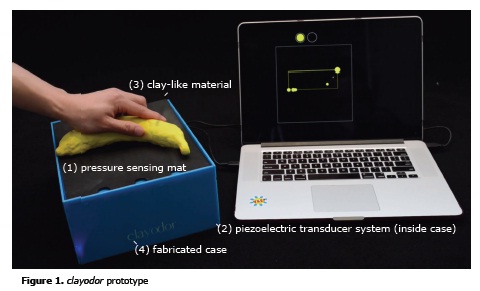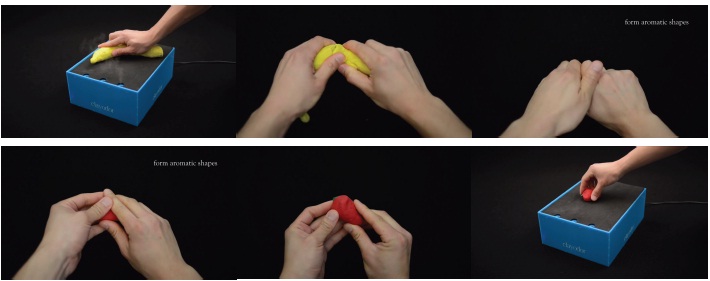





Published on Feb 14, 2025
clayodor (\klei-o-dor\) is a clay-like malleable material that changes smell based on user manipulation of its shape. This work explores the tangibility of shape changing materials to capture smell, an ephemeral and intangible sensory input. We present the design of a proof-of-concept prototype, and discussions on the challenges of navigating smell though form.
Recent HCI research has moved beyond static and rigid physical interfaces to dynamically controlled materials. For example, research has explored materials with dynamically changing qualities such as shape, stiffness, weight, and optical properties. For the last decade, researchers from CMU and Intel have worked towards the realization of Claytronics, a future material composed by nanoscale computers in the form of atoms. This will potentially enable direct and dynamic user manipulations with programmable materials. Building on top of the possibilities of shape changing interfaces, we envision clayodor, a clay-like malleable material that changes smell based on user manipulation of its shape.
We explore the tangibility of shaping a malleable material to capture an ephemeral and intangible sensor input: smell. By allowing users to take this material into their hands and physically shape it into various meaningful forms, we are aiming to explore the potential mental model of coupling these forms with smells. Similarly, Obrist et al [13] has also indicated the evocative quality of scent to connect people to memories and past experiences. However, there is no focus on the power for objects to be used as a symbol in the production or recall of smell. Further, we posit that because smell is a distinctively difficult sense to describe, shaping and molding objects has potential to forgo the necessity for users to attempt at providing descriptions of smells for recall. On a poetic note, our work explores how shaping materials into symbolic forms serves as triggers to scents that connect people to past experiences.
In this paper, we present a prototypical implementation of a malleable interface combined with smell-composing device. The prototype is technically interesting, but yet in a preliminary form as its size is big and it has a limited sensing capability. However, we envision clayodor to be a material consisting of voxels embedded with tiny pressure sensors and scentreleasing discs. Various deformed shapes would create different pressure distributions and trigger the discs to release corresponding smells. The discussion on limitations of current technology will be presented in later sections.
The history of olfactory research can be dated to Sensorama [8] in 1962. Ten years ago, the HCI research community started looking into the challenges and possibilities for smell-based technology [9]. One main challenge is the complexity to produce arbitrary smells on demand. Humans have a thousand different olfactory receptors in our nose, each sensing a different chemical bond [10]. Reproducing arbitrary smell would therefore require a thousand-dimension space, which presents significant challenges compared to the 3- dimensional space of vision (RGB). Another challenge is the difficulty of creating as systemic and reproducible classification scheme for smell. As humans refer to smells through ambiguous descriptions, it is difficult to create rigorous categorization for universal reference.

Recent HCI research efforts focus on user interaction with smell-based technology, rather than the chemical engineering challenge of reproducing specific scents. To the best of our knowledge, most systems use off the shelf aromas in their prototypes, focusing research effort on interaction design. Brewster et al. developed a smell-based photo-tagging tool (Olfoto) to elicit memories though smell. Commercial product Scentee lets you associate particular smells with smartphone notifications. The Smelling Screen is a display system that can generate smell distribution on a 2D screen. Ranasinghe et al. explored using smell for digital communication, enabling the sharing of smell over the Internet. By recreating smell though form, clayodor explores the possibility of form as a user-designated navigator for smell.
Due to current technical limitations, e.g., sensor size and sensitivity, we implement the proof-of-concept prototype through external sensing and clay-like material. The current prototype allows us to explore user interactions and elicit insight. The prototype (Figure 1) consists of
(1) a pressure sensing multi-touch mat from TactonicTechnologies ,
(2) an Arduino controlled piezoelectric transducer system that generates scent by vaporizing liquid fragrances
(3) clay material for user manipulation, and
(4) a fabricated case.
Users can form the clay material into different shapes, and place it onto the pressure-sensing mat. The mat is integrated with a machine-learning algorithm that distinguishes between different shapes. Once the shape is detected and recognized, the piezoelectric transducer system triggers the respective scent. The piezoelectric transducer system consists of multiple small discs connected to containers filled with different scented liquids. When a certain signal is received, the corresponding disc starts vibrating at high frequency, turning liquid into vapor.
In this application we enable users to form the shapes of objects according to their mental modals, and retrieve the smell associated with the shapes. Figure 2 presents an application to retrieve fruit scent. To smell the scent of certain fruits, the users can shape the material into the form of the fruit based on their mental modals, and clayodor will release the corresponding scent.
From the study by Obrist et. al. [13] on human perceptions towards smell, the strongest quality people saw in smell was its ability to connect them to the past. We explore how clayodor recalls past memories by enabling users to reshape objects that are etched into their minds. An example is a user who is recalling the scent of her grandmother’s homemade buns. By reshaping clayodor to the shape of buns, it starts giving off the smell of the buns she misses so much, bringing her back to her childhood memory.

Retrieving the intangible through the tangible This work is fundamentally exploring the question of capturing the ephemeral though the tangible. However, this raises the question of whether tangible form is the most intuitive mental link to smell for humans. What about linking a visual image with smell? Or even a color with smell? Or even a sound with smell? Which would be the most intuitive and rich connection to retrieve this ephemeral sense? Or does it vary based on different scenarios? With clayodor as a first exploration, we see this as a rich space for future research. Mapping smell and form This work raises the question of the feasibility of mapping form with smell. What granularity of recognition would the system need to support? For instance, for the system to distinguish between an orange and a peach, which are both round, the system would need to support recognition of texture and fine details. This would also pose challenge on the user, who would have to shape the subtle differences with their hands. We see the need to articulate a basic design vocabulary to map form and smell.
In this paper, we presented a prototypical system that allows retrieving scents through manipulating malleable tangible interface. By fusing pressure sensing and scent-composing technology, we explored the possibility of fine-grained navigation through different smells via tangible interaction. The current prototype is not well integrated, however, we envision that clayodor will be a material consisting of voxels comprising tiny pressure sensors and scent-releasing discs because each hardware modules’ can be easily reduced to small sizes. The next step towards this vision is to make modular blocks consisting of those hardware modules.
[1] Claytronics Project. https://www.cs.cmu.edu/~./claytronics/
[2] Scentee Product. https://www.scentee.com/
[3] Tactonic Technologies. https://www.tactonic.com/
[4] Brewster, S., McGookin, D., Miller, C. Olfoto: designing a smell-based interaction. Proc. CHI (2006), 653–662.
[5] Coelho, M. and Zigelbaum, J., Shape-changing interfaces. Personal and Ubiquitous Computing Vol.15, Issue 2, Springer-Verlag London (2010), 161–173.
| Are you interested in this topic.Then mail to us immediately to get the full report.
email :- contactv2@gmail.com |